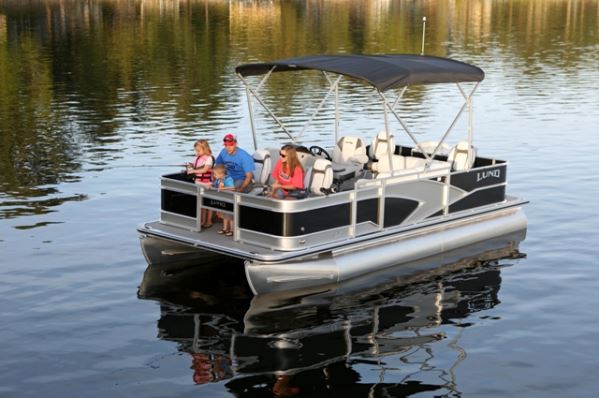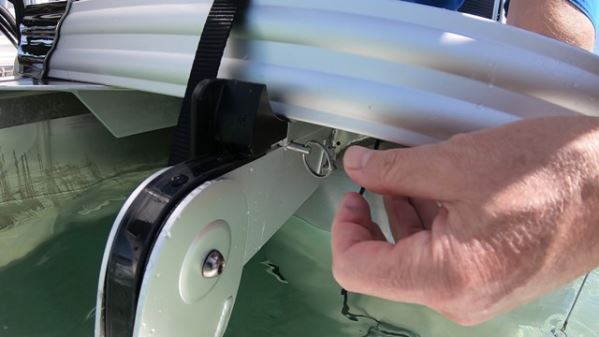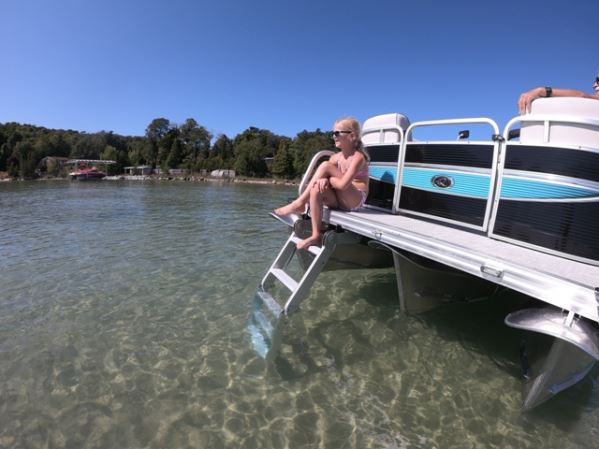
How to Start Fishing with Kids
.jpg_600.jpg) For many serious anglers, fishing memories go back to early childhood. Some got started fishing so early that they can’t recall their first trip. Fishing runs in their families and gets passed down through the generations. But what about when that’s not the case? What happens when a child asks a parent to take them fishing, and that parent has minimal fishing experience? Getting started can feel overwhelming.
For many serious anglers, fishing memories go back to early childhood. Some got started fishing so early that they can’t recall their first trip. Fishing runs in their families and gets passed down through the generations. But what about when that’s not the case? What happens when a child asks a parent to take them fishing, and that parent has minimal fishing experience? Getting started can feel overwhelming.
Stephen Neil, 41, of Franklin, Tenn., spends a lot of time on the water and previously guided professionally in Alaska. He says parents that know his fishing background frequently give him a call and ask, “Where do I even start?” Those calls picked up in frequency in 2020, as families discovered fishing as a safe activity during the pandemic.
“I read this article (about the value of fishing for building relationships among families) by the Tennessee Wildlife Resources Agency that came out during the pandemic,” said Neil, “and I think it is just perfect. Fishing is such a great sport for families.”
Neil offers these 10 tips to anyone facing the somewhat daunting task of taking a child fishing while learning how to fish at the same time. If you want to see some of his advice in action, check out this helpful video at the base of this article..JPG_600.jpg) Tip 1 – Use live bait
Tip 1 – Use live bait
The first thing Neil always tells people is to start with live bait. Fish already want to eat worms and minnows, so they don’t have to be tricked. The number of lure options on the shelves is overwhelming. Learning to fish those lures takes time. Starting with live bait keeps it simple.
Tip 2 – Use light line
Light line casts easily, allows the bait to move naturally and generates more bites than heavy line. A lot of basic rod and reel combos come off the shelf pre-spooled with line that is too heavy. Neil suggests 6- or 8-pound-test line.
Tip 3 – Target visible cover
Fish live around treetops, boat docks, sticks and other types of visible cover, so fishing near these targets increases the chance that you’re near fish. It’s also much easier to find cover sticking out of the water than underwater cover..JPG_600.jpg) Tip 4 – Be open to multiple species
Tip 4 – Be open to multiple species
Getting bites, catching fish and seeing results are critical to gaining confidence for everyone starting out. A lot of people eventually dedicate themselves to individual species, but that’s not necessary when getting started. Neil suggests fishing for whatever species is biting. There are times of year when certain fish are easier to catch, usually due to the spawning cycle, and those situations provide good opportunities, too. There’s a saying, “I don’t enjoy fishing as much as I enjoy catching.” It’s true. Catching any fish is way more fun than not catching a particular target species. Most kids are completely content if they catch anything the first few times out.
Tip 5 – Keep it active
Boredom can end a fishing trip quickly for young kids, so try to keep things active. Using bobbers gives everyone something to watch. If fishing is slow, move around. Typically, with live bait, if fish don’t bite in the first few casts, it’s best to move on to the next good-looking spot. A change of scenery is often the solution to slow fishing. Tip 6 – Ask for some help
Tip 6 – Ask for some help
If you want to avoid too much fishing and not enough catching, don’t be afraid to ask for some help before a fishing trip. Having a general idea of where to start ahead of time is important. It is also fun to talk to a friend before and after the trip. Ask if they have been on the water lately. Ask how deep they were catching fish. They might even suggest a couple of spots. If the trip goes well, the friend will love to hear all about it and might provide more help for the next trip.
It’s also wise to have a few cellphone numbers handy in case of a confusing or emergency situation, whether with the gear, the boat or the fish.
Tip 7 – Go with a friend
If the first couple trips don’t pan out, going with a friend is a good move. Seeing them catch fish with a technique is much more helpful than just reading about a technique or watching someone do it online. Ask a lot of questions on the trip. Be a sponge for information. When a fish gets caught, ask why it was there and if fish are likely to be there often or just during that time of year..tif_600.jpg) Tip 8 – Keep kids entertained
Tip 8 – Keep kids entertained
This point can’t be stressed enough: Don’t expect kids to hang in there for long periods. Starting them out with short trips in good weather is worth the effort in the long term. Playing in the minnow and worm buckets is an excellent way to occupy their attention. Put caught fish in the livewell or a bucket and let the kids watch them swim around. Where regulations allow, fish can be returned to the water later (see Tip 9 regarding regulations). If the fishing is slow, make sure to keep the kids entertained. If it gets hot, let them jump in. Bring lots of drinks and snacks.
Tip 9 – Know the regulations
Learning the rules for keeping fish is important. Size and creel limits are put in place by each state wildlife agency and sometimes vary between fisheries within the state. Typically, when buying an annual fishing license (don’t forget that!), a list of regulations is made available. Know the rules for keeping fish, and certainly know the rules for boating equipment (life jackets, engine safety cutoff switches, etc.)
Tip 10 – Take some fish home
A meal of fresh fish is a real benefit of a good fishing trip. Perhaps not everyone in the family could go fishing, but they can all enjoy a meal. Putting food on the table often helps motivate the family to enjoy more fishing trips together, too. For tips on how to fillet fish, click here.
Regardless of whether you keep fish to eat, starting a new family tradition by fishing together is a great way to create lifelong memories. It’s also a great activity to learn together. Give it a shot!
This article is courtest of Pontoon and Deck Boat magazine, for more information and more articles, please visit pdbmagazine.com

What Are The Differences Between A Catamaran And Pontoon Boat?
Pic By: Dream Yacht Charter
Some of these differences are observable while others are not. Catamaran and Pontoon are both made up of two hulls or pontoons (usually of the same size else you would be having an outrigger or a proa) connected with a wing-like structure.
Some folks consider both as basically the same and suggest catamaran is just a type of pontoon and some think their differences are basically on their usage and a pontoon would technically be called a catamaran.
The name “Catamaran” was derived from the word “Kattumaram” which in Talim means “tied wood”. The ancient vessel from which we got so many derivatives was just two logs of wood connected by smaller logs of wood and accommodations were made on the smaller logs above the hulls.
The modern catamaran and pontoons come with different designs. The sophistication of modern engineering is so evident in the production of these boats. While the pontoon might be as simple as a deck placed on two pontoons to a bit more complex designs, the catamaran has pontoons which are usually a part of the structure of the boat with different spaces.
These spaces can be used as residence or for storage. Most of the catamarans also have a mast with a canvas in between the pontoons. Catamarans come with different complex designs that will best suit the desired use.
Simple pontoons are usually used for pleasure cruise or fishing in smaller water bodies like rivers and lake. The water surface shouldn’t have high water current and is not dramatically affected by a change in weather conditions. The use of pontoons in open seas and ocean is highly prohibited because it is not structurally designed for such an environment.
The pontoon shape does not cut through waves. Its wave handling capacity is poor. They cannot maneuver effectively in rough water bodies. Meanwhile, catamarans can sail the seas or oceans because they are designed to handle such an environment and they can cut through waves.
The pontoons are usually not large. Most pontoons are between 15-40 feet and 8-12 feet wide with the outboard motor placed behind. While the Catamarans are usually very large and their motors are usually in the pontoon tube.
There is also an observable difference in the speed of both the pontoon boat and the catamaran. The feature is also related to their intended use with the different types of water bodies. A pontoon boat can attain a speed of about 26 miles per hour while a catamaran was designed to move faster, up to about 50 miles per hour.
A buyer who is interested in getting a pontoon can purchase one between $12,000 to about $75,000 while a catamaran can go for a price ranging from $60,000 to above $2 million.
For All Your Accessories and/or Vinyl Flooring Visit Pontoon-Depot's Shop Site.
- Amy Cabanas
- Tags: Boating Entertainment pontoon boat Pontoon Boat Operating summer tips

Revolutionary Pontoon Ladder: New REVO A True Game-Changer
By: pdbmagazine

The next big thing for pontoon owners might just be the LilliPad REVO Ladder. The new boarding ladder sets the bar for comfort and functionality while offering an unrivaled array of features and benefits. LilliPad Marine has a reputation for getting boaters in-the-water with its Innovation Award Winning LilliPad Diving Board and is committed to making the process of re-boarding comfortable for all boaters.
REVO Ladders fasten to boats using a modular mounting system. With mount brackets installed at both locations, it can easily be moved from stern to bow making the ladder versatile for deep water swimming or an afternoon at the sandbar.
Releasing or securing the ladder to its mounts is as simple as pulling or inserting two locking pins. The REVO Ladder also boasts an impressive 48-inch (below the deck), 5-step design when deployed. The ladder’s deployed shape has been carefully crafted with an obtuse angle that positions the lower portion vertical and the upper portion sloped. REVO’s shape is critical in eliminating the need for flexibility or upper body strength to climb the ladder with ease. In addition, the ladder’s wide, slip-resistant, ergonomic-steps and beefy structure provide unmatched comfort and stability.
While REVO is deep when deployed, when retracted it sits only 16 inches above the deck presenting an aesthetically pleasing low profile. Furthermore, the REVO Ladder can be deployed and retracted from a standing position thanks to its innovative folding design and retracting strap. Thus, no kneeling or leaning over into the water to deploy or stow your ladder is required.
REVO Ladders are designed to exceed industry standards. Each ladder is built with heavy wall aluminum extrusions, robust (internal) stainless-steel cables, and stainless hardware. In addition, the ladder is self draining, eliminating the ability to freeze and crack. REVO Ladders are also suitable for dock mount applications boasting the same great features and benefits of the boat boarding ladder. Especially noted by homeowners is the ladder's ability to fold, eliminating the rigid, algae-covered ladders found on most docks.
For All Your Accessories and/or Vinyl Flooring Visit Pontoon-Depot's Shop Site.
- Amy Cabanas
- Tags: Boat Ladders Boating Boating Safety Family pontoon boat Pontoon Boat Operating safe boating habits summer tips

Heavy Boat Traffic Expected For Labor Day Weekend
By: Kiwaradio
Statewide Iowa — Boaters heading out for the Labor Day holiday will likely find busy waterways across the state.
Susan Stocker, boating law administrator and education coordinator for the Iowa Department of Natural Resources, said boat operators need to operate with caution and to watch for hazards in the water.
The weekend weather forecast is favorable for boaters and combined with a three day weekend should produce heavy boat traffic. Stocker said ramps will likely be busy, placing boating etiquette at a premium.
“Everyone is excited to get on the water,” she said. “Be patient, and when it’s your turn be ready to launch. Courtesy on the water goes a long way in avoiding problems.”
She said an obvious way to prevent problems is for boat operators to avoid alcohol while operating the craft.
“We want boaters to have fun on the water, but we don’t want that fun to end in a boating tragedy. Boaters need to keep safety in mind while on the water,” Stocker said.
Preparing for a safe day on the water begins in the driveway. Make sure to have a properly fitting life jacket for each person on board and that all of the safety equipment, including a properly working fire extinguisher, is on board.
“Remember, life jackets only work when worn,” Stocker said. “Life jackets float, you don’t.”
For All Your Accessories and/or Vinyl Flooring Visit Pontoon-Depot's Shop Site.
- Amy Cabanas
- Tags: Boating Boating Safety DIY Entertainment Family pontoon boat summer tips
